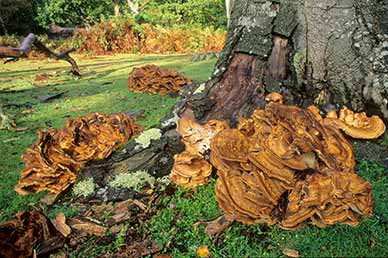Giant Polypore (Meripilus giganteus)

Giant Polypore fungi are usually whoppers, just as the name suggests - in some cases, up to a massive 80 centimetres across. What's more, in autumn they're reasonably common and widespread in parts of the New Forest and often grow in huge, overlapping swathes of flattened, fan-shaped caps, each on the upper surface with alternately light and dark brown zones of colour.
Difficult to miss, then? Certainly. It's just a shame that they are not particularly edible, although some authorities suggest that they're good when young, albeit with an acidic taste and somewhat leathery texture; whilst other say that sour taste and fibrous texture renders them inedible.
Although most often found growing around the base of beech trees, Giant Polypores have also been found on oaks. Somewhat confusingly, they can also seem to appear to sprout directly from the ground, but are, in fact, invariably attached to buried tree roots.
Warning: refer to a good, comprehensive fungus field guide to confirm identification, and only eat those species known without any doubt whatsoever to be edible - people have died after eating certain poisonous specimens.
References:
Mushrooms and other Fungi of Great Britain and Europe - Roger Phillips
The Mushrooms and Toadstools of Britain and North-western Europe - Marcel Bon
Fungi of Britain and Europe - Stefan Buczacki and John Wilkinson
The MacDonald Encyclopedia of Mushrooms and Toadstools - Giovanni Pacioni
Fungi of the New Forest: A Mycota - Edited by Gordon Dickson and Ann Leonard
A Passion for Mushrooms - Antonio Carluccio
More links
Other related links
Search this site

Sadly, 58 animals were killed - 35 ponies, 13 cows, 8 donkeys and 2 sheep, whilst a further 32 were injured - 3 pigs, 9 donkeys, 11 cows and 9 ponies.
(Forty-three accidents occurred in daylight, 15 at twilight and 101 in the dark. Twenty-seven accidents were not reported by the driver involved).
Here's just one horrific example - Three donkeys killed in collision with van at notorious New Forest blackspot (Advertiser and Times)

